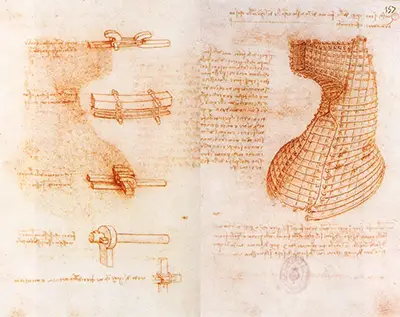The chalk sketch shows detailed plans for the Sforza Horse, an enormous and impressive statue planned by Da Vinci.
Da Vinci dedicated much of his life to plans for the monument, which would have been the largest equestrian statue in the world at the time.
Unfortunately, his plans never developed beyond this set of sketches and similar draftings and a clay model, which was destroyed by advancing French troops in 1499, putting an abrupt end to the project.
The detailed sketches give the viewer a clear sense of the sheer scale of Da Vinci's vision for the statue. The modules depicted would have been required simply to produce the head and neck of the horse, further moods would have been required for the rest of the creature's body.
Whilst it is not the most well known of Da Vinci's technical drawings, his plans for an flying machine which some have interpreted as a predecessor to the modern day helicopter have done far more to capture the public imagination, it remains fascinating thanks to the amount of work that went into the project of the back of Da Vinci's drawings.
The drawing also includes fairly detailed plans that would have allowed Da Vinci and his collaborators to monitor the construction process of the statue.
This included fairly detailed calculations of how much bronze would be required to complete the head and neck molds, as well as practical considerations as to how the statue would actually be fitted together once the various elements had been completed.
Despite the failure of the project during Da Vinci's lifetime, a number of retrospective attempts have been made to complete the statue to Da Vinci's original plans, using the surviving reference materials. One of the most notable of these is generally known as the Modern Horse.
The work was the brainchild of a commercial airline pilot and cost around $2.5 million to complete. There have been at least five other 20th Century attempts to complete the work to Da Vinci's original specifications located in various locations across the United States and the world.
Casting Mold of the Head and Neck of the Sforza horse is now in the possession of Spain's National Libraty, the Biblioteca Nacional de España. It sits in the library's impressive manuscript collection alongside a number of other Da Vinci plans and sketches.
Despite the failure of the Sforza Horse, Da Vinci went on to consider another, relatively similar statue. This statue also failed to move beyond the design phase. The main remaining relic is a beeswax statue believed to have been completed between 1508 and 1511, around a decade after the final failure of the Sforza Horse project. Due to the materials used, this physical example of Da Vinci's design is in far worse condition than the Casting Mold of the Head and Neck.


